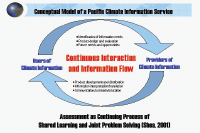Lessons learned from the Pacific ENSO Applications Center (PEAC): building a climate information system in the Pacific
Eileen L. Shea Climate Projects Coordinator, East-West Center and Interim Director, NOAA Integrated Data and Environmental Applications Center
In the Pacific – and elsewhere in the world – recent events such as the 1997-1998 El Niño have provided evidence that climate forecast and assessment information is helping to enhance resilience in water resource management, disaster management (including drought, flood and fire management as well as tropical cyclones), agriculture, health, fisheries, tourism, and other sectors. Scientists and government officials in the American Flag and U.S. Affiliated Pacific Islands agree advanced forecast information, coupled with education and outreach, provided by the Pacific ENSO Applications Center (PEAC) helped to mitigate the negative impacts of the 1997-1998 El Niño event and continued to provide valuable information to support decision-making. Initiated in 1994 as a research pilot project, the PEAC was established as a partnership involving the U.S. National Oceanic and Atmospheric Administration (NOAA) through the NOAA Climate Program Office (formerly Office of Global Programs) and the U.S. National Weather Service, the University of Hawaii, the University of Guam, and the Pacific Basin Development Council (the Governors of Hawaii, Guam, American Samoa, and the Commonwealth of the Northern Mariana Islands). Steps toward the transition of PEAC from research to operations began in 2000 with responsibility assigned to the U.S. National Weather Service Pacific Region (NWS PR). Additional information can be found on the PEAC website (lumahai.soest.hawaii.edu/Enso).
With support from the NOAA Climate Office, the author is completing a review of the first decade of PEAC operations (details on PEAC review can be found at, research.eastwestcenter.org/climate/PEAC. Based upon this on-going study, the following is a brief description of some of the lessons learned.

Early and continuous partnership and collaboration with users is essential. It was found climate forecasting services should use a continuous, collaborative, participatory process which engages the users of climate information products as well as the providers of that information in a process of shared learning and joint problem solving (see Figure 1). This process should encourage interaction among and across user communities and recognise the dynamic, evolutionary character of changing climate, social, and economic conditions. Policy responses and the climate service should reflect an iterative, adaptive approach with continuous evaluation and revision as conditions change.
Education, outreach and dialogue -- a critical role. Early and continuing education and outreach efforts: 1) help raise awareness and improve understanding of climate system processes and local impacts; 2) enable climate information providers and users to explore solutions and identify opportunities to enhance the resilience of communities, businesses, and resources; and 3) build trust and credibility, an essential characteristic and a long-term endeavour requiring sustained interaction among both individuals and institutions. As a PEAC team member likes to say, establishing and sustaining "eyeball-to-eyeball" contact is essential.
The PEAC experience also shows the importance of: 1) building on existing institutions and trusted information brokers; 2) effectively engaging the national meteorological services, key ministries, local experts, community leaders, and the media; 3) a sustained partnership among climate information users and providers helps to maintain awareness between individual events; and 4) an opportunity to establish a climate information system as opposed to only an event-based, early warning system.
Forecasts of future conditions must be set in an appropriate context. Establishing a climate information system should start with a clear understanding of the problem being addressed – managing water resources, disaster preparedness, coral reef management, etc. Partners in a climate information system should focus on the development and dissemination of useful and usable information and forecasts which are appropriate to the intended application and decision-making community. Responses to future events will benefit from setting future conditions in an historical context that integrates traditional knowledge and practices as well as instrumental records.
Decision makers in many sectors are interested in climate information on a continuum of timescales from extreme events through seasonal, inter-annual, and decades and longer timescales. Extreme events such as droughts, floods, or tropical cyclones can be a galvanising focus for planning, response, and capacity-building. In addition, enhancing a community’s resilience to year-to-year climate variability can play an important role in developing climate adaptation programmes. Strong partnerships between weather and climate communities in technical and policy arenas are important in exploring the interactions of climate processes across timescales and establish a climate information system which will address today’s problems and support future planning.
According to James Weyman, U.S. NWS PR, the results of the PEAC Review will provide a strategic plan or "roadmap" for future U.S. climate services in the Pacific and be a focus for U.S. contributions to the World Meteorological Organization’s Regional Climate Centre for Oceania. The above results are offered to support our shared journey toward sustained climate information systems and the mainstreaming of climate information to support adaptation in the face of climate variability and change.
